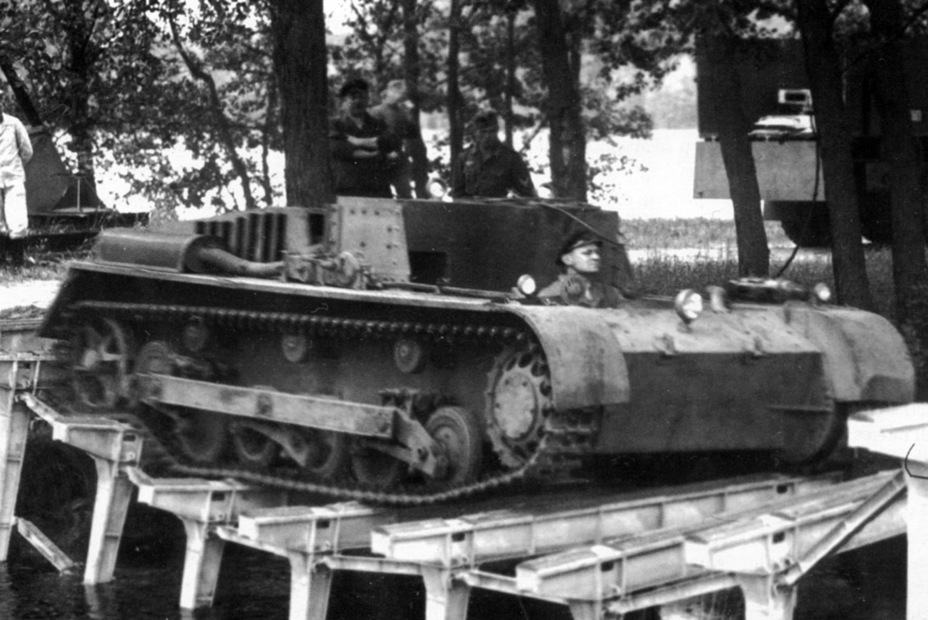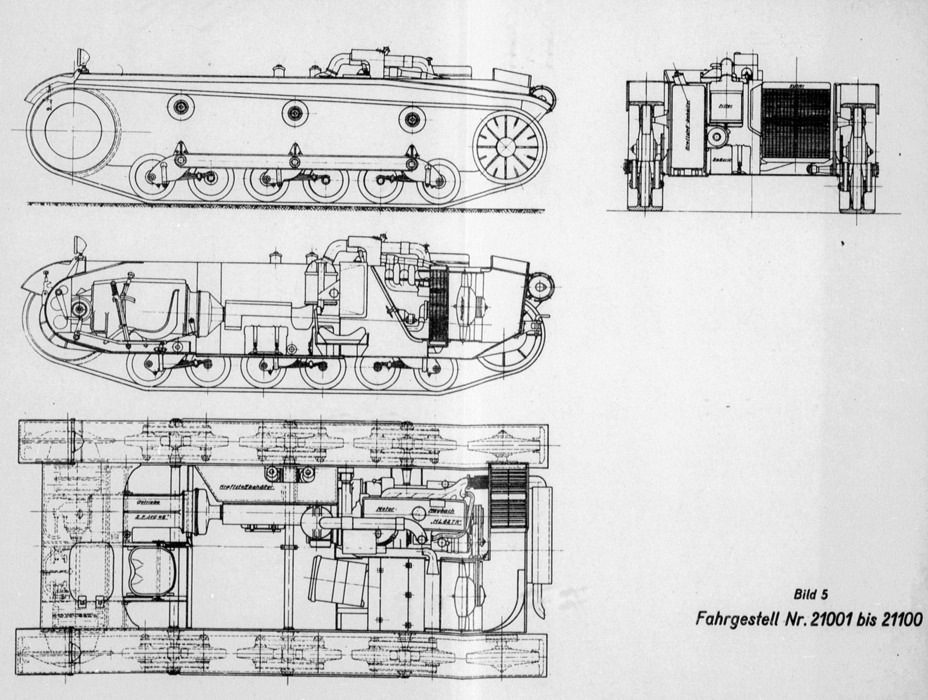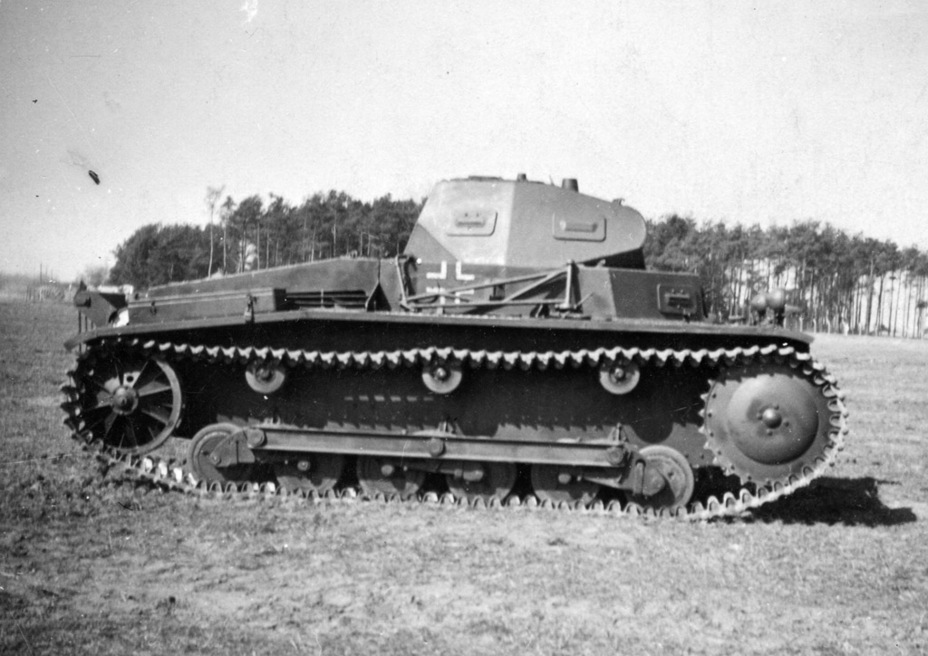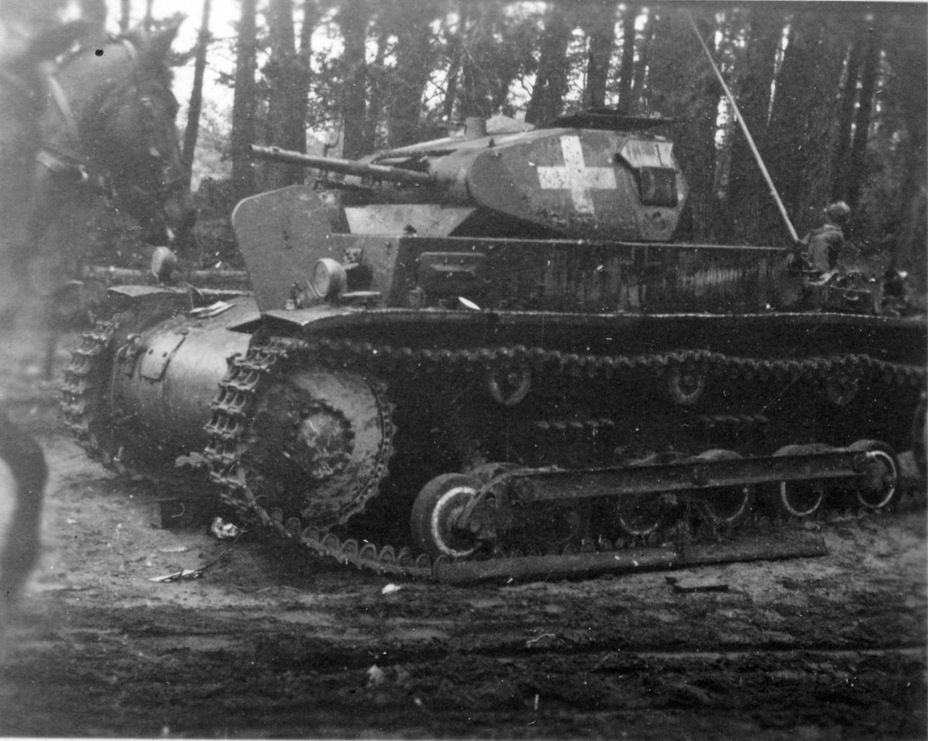The light PzII tank played an important role in the structure of the German tank forces. Despite the opinion born of German generals' memoirs, this was not a training tank. On the contrary: at the time of its inception, the PzII was one of the best light tanks in the world. It appeared almost by accident, but occupied a significant part of the Wehrmacht's order of battle. The PzII remained in production for five years, with some small breaks. What is the history of the PzII, and what did its first versions look like?
Tractor with an autocannon
In February of 1930, the issue of building a 3 ton tank with a 60 hp engine armed with a 20 mm autocannon was first raised in Germany. This tank was called «Kleintraktor», or «small tractor». Initially, it was supposed to be similar to the Leichttraktor, with an engine in the front and fighting compartment in the back.
After trials of the Leichttraktor Krupp and Leichttraktor Rheinmetall it became clear that the layout with a rear transmission is poor. In 1931, Germany purchased three British Carden-Loyd tractors through a shell company. They served as the foundation for the development of a new Kleintraktor by Krupp, this time with a front transmission and rear engine. On July 1st, 1933, the tank received a new name: La.S. (Landwirtschaftliche Schlepper, «agricultural tractor»).
There was an issue with the armament. The tank was supposed to fit three men, but the only way to do that and install a 20 mm cannon while staying within the mass and size restrictions was to use an immobile casemate. Krupp designed such a solution back in 1931. At the same time, another company, Rheinmetall, began working on the installation of a 20 mm gun. However, on October 12th, 1932, General Oswald Lutz, responsible for the motorization of the Reichswehr, stated his preference for a variant with a turret and two machineguns. The immobile casemate idea was rejected, but not for long.

In January of 1934, the 6th Department of the Armament Directorate commenced the development of a new light tank. Initially, it was called verstaerkter Kleintraktor 6 to, or «reinforced small tractor, 6 ton class». This was the third tank called «Kleintraktor». Just like the first tank of that name, which later turned into the Leichttraktor, it had a mass of 6 tons. On February 24th, 1934, the name was changed to La.S.100 (agricultural tractor with 100 hp engine).
In reality, work on the La.S.100 began even earlier than that. Krupp's report dated December 22nd, 1933 already mentioned a tank that was larger than the La.S. and had a 20 mm autocannon. The report said that it was being developed by Daimler-Benz, but that is not exactly the case. In reality, Daimler-Benz was working on the turret and turret platform, as with the La.S. As for the chassis, that was a job for Krupp. According to the initial plans, the first experimental prototype would be finished by the end of 1934.
However, the monopoly of the arms giant from Essen did not last long. Krupp presented a three-man 6 ton tank in March of 1934. However, it looks like the 6th Department wanted a backup plan. After all, the La.S., which was in development for three years, had several serious issues, especially when it came to the engine and some suspension elements. As a result, it had to be seriously redesigned.
The German military did not want a repeat of this situation, and the monopoly turned into a contest in June of 1934. Maschinenfabrik Augsburg-Nürnberg AG (MAN) entered the fray. The work was overseen by Friedrich Rief, one of the company's leading engineers. MAN looked like a serious competitor, especially since La.S. production was already being implemented in Nurnberg, in addition to production of heavy trucks and diesel engines.

In order to accelerate development, the suspension was «borrowed» from the La.S., with some changes. The track links, suspension elements, and road wheels were very similar. The overall concept was also reminiscent of the lighter tank.
The 120 hp Maybach 52 5.2 L engine was used as the power plant. The 100 hp MAN engine was considered as an alternative. The mass of the chassis was limited to 6 tons, and the turret and turret platform would add 2 more. MAN's project documentation was awaited by early July of 1934.
In July, the Henschel & Sohn company joined the project, which was also setting up for production of the La.S. in Kassel. Like MAN, Henschel produced trucks, and also locomotives. Unfortunately, precise information about the Henschel project did not survive to this day. However, it is known that the three vehicles were very similar. All of them used the Maybach HL 52, later replaced with the 130 hp HL 57, the ZF SSG 45 transmission, and even had a similar hull length (4600-4700 mm). The Krupp La.S.100 also had 6 road wheels per side, a similar hull to the La.S., and a similar layout.

On July 12th, 1934, the German military decided to order 1000 La.S. tanks. This decision was directly linked to the rise of the Nazis in power and subsequent change in foreign policy. At the same time, orders to accelerate La.S.100 development came from the top. The first experimental prototypes were expected by January of 1935.
Of course, wishes are one thing, but reality is another. In reality, the companies had their specifications and wooden models ready by the fall of 1934, but production of prototypes would take a lot longer. Krupp's engineers were doing better than their competitors, announcing that trials were completed successfully and subsequent work is ongoing. However, this assertion raises some questions. The only known photograph of the Krupp prototype shows that it received a reinforcement beam for its suspension.

Closer to the summer, two experimental prototypes each were delivered by Henschel and MAN. Each experimental tank was noticeably different. As a result, changes were made to the hull, suspension, and internal components. MAN's La.S.100 won the day, and this company's second prototype served as a test bed for the Daimler-Benz turret and turret platform. Since there is no information on the Henschel prototype, it is hard to compare it to MAN's. However, the tank was clearly superior to Krupp's entrant. MAN's engineers created a roomy fighting compartment, which could fit three crewmen. It was also easier to access the tank's components.
Trial batch
According to initial plans, production of the La.S.100 would start in the winter-spring of 1936. A contract was signed for production of the first 75 tanks in October of 1935, initially called the zeroth batch, but quickly renamed to 1.Serie/La.S.100. Production would start in April of 1936, and the last deliveries of the series would come in September.
The name of the new tank changed three times. In late May of 1935, it became known as 2 cm M.G. Panzerwagen (Vs.Kfz.622) (armoured vehicle with 20 mm machinegun, experimental vehicle 622). On January 15th, 1936, it was renamed to 2 cm M.G. Panzerkampfwagen, and, on April 3rd, it finally received its widely known name: Panzerkampfwagen II (2 cm) and index Sd.Kfz.121.

The order for PzII tanks was split into three batches of 25 vehicles each. The first batch was called PzII Ausf.a/1, the second PzII Ausf.a/2, and third PzII Ausf.a/3. This strategy had its reasons. The military remembered the PzI Ausf. A, which was a good design, but was plagued by many minor (and some not so minor) defects. Some of them caused a serious redesign of the tank, resulting in the PzI Ausf. B. It was more logical to discover issues in small batches of tanks, instead of producing hundreds of «raw» vehicles and then dealing with all of them at once.

Even though the PzII looked like the PzI, the difficult technical task led to a number of unconventional solutions. The tank's crew included a radio operator, which needed a separate spot. In addition, the 1200 mm turret ring needed a lot of room.
In order to deal with that, the engine, transmission, and driveshaft were moved to the right. The fuel tank was also moved. Of course, a fuel tank in the fighting compartment is a bad idea, but there was nowhere else for it to go. The fuel tank was filled through two access ports in the right of the turret platform. The radiator and its air intake was placed to the left of the engine. The exhaust ventilator did not fit, and an indentation was made for it in the rear plate.
Since the transmission was placed to the right of the driver, the radio operator received a place right in front of the air intake. In an emergency, he could collapse the sloped wall and climb out through the engine deck. There was another hatch in front of the driver, in the curved front plate. Formally, it was meant for servicing the transmission, but it was often used to enter and exit the tank. It was not very comfortable, but simpler and quicker than waiting for the commander to climb out of the turret and free up the hatch. Since there was not much room left, it was impossible to slope the tank's armour.

The PzII's turret was also significantly different from the one that Daimler-Benz designed for the PzI. This time, the engineers managed to do without complex curves, like on the hull. Tanks from the first batch had turret platforms and turrets welded from high nickel steel. Thanks to this, the thickness of the armour did not have to be higher than 13 mm to protect from rifle caliber bullets. However, this was an expensive solution.
The gun mantlet, which protected the 20 mm KwK autocannon, based on the 2 cm Flak 30 AA gun, and MG 34 machinegun, looked closer to its predecessor's. Compared to the Flak 30, the barrel of the KwK 30 was shortened from 65 to 55 calibers, and the magazine capacity reduced from 20 to 10 rounds. The reduction in volume made it easier to load the gun in the cramped fighting compartment and easier to store ammunition. On the other hand, a burst of 10 shots is often not enough.
Despite a series of compromises, MAN engineers created a decent tank in combination with Daimler-Benz. However, it still had a long way to go.

The producer did not manage to meet expectations. According to documents, only the 25 PzII Ausf.a/1 were ready by October 1st. These tanks received serial numbers from 20001 to 20025. The first 10 tanks had rubber rimmed idlers, just like the prototypes. Starting with tank 200011, the idler became fully metallic. The access to the cooling system fan was also changed starting with this tank.
New changes were also introduced in the second batch, PzII Ausf.a/2, serial numbers 20026-20050. Access hatches to the fuel pump and oil filter were added in the floor. PzII Ausf. a/3, serial numbers 20051-20075, were also modified. They received a larger radiator, and a tow cable, carried on the front. The suspension was also altered.

Tanks from the second series received much more noticeable modifications. The 2.Serie/La.S.100 was mentioned during a meeting on June 17th, 1936. By that moment, it was clear that the PzII would be produced in large numbers. The 2.Serie/La.S.100, or PzII Ausf.b, would be the first large order. 100 tanks were ordered overall.
It was assumed that the rate of production could be increased to 25-35 per month, for which other companies, including Henschel, would have to be involved. However, reality made its corrections again: the first PzII Ausf.b tanks (serial numbers 21001-21100) were only finished in the spring of 1937. The order was fully completed by the fall.

The PzII Ausf.b was built out of simpler and cheaper steel. To compensate, the thickness of the armour was increased from 13 to 14.5 mm. The mass increased from 7.6 to 7.9 tons, but this did not reflect on the tank's characteristics significantly. The length of the hull increased by 35 cm, which increased the size of the engine compartment and allowed for a new cooling system, which moved the weakly protected fan away from enemy fire.
The tank received a new muffler, and the rear plate lost its indentation. The running gear was also redone. New road wheels, drive sprockets, and return rollers were used. The width of track links increased from 280 to 300 mm. The Ausf.b got rid of its predecessor's significant drawbacks and became the first battle-worthy PzII. However, the changes were not done yet.
Achilles' heel
Even though MAN was taking its time with production of the first PzIIs, these tanks began entering the military by early 1937. They were eagerly expected. Even though it was obvious that they need more work, the Wehrmacht had no alternatives at the time. The Z.W. medium tank, better known as the PzIII, was behind schedule, and the first tanks that were built had a ton of issues. The B.W. support tank, or PzIV, was not doing much better. The contract for 35 1.Serie/B.W. tanks was only signed in December of 1936.
Meanwhile, bad news were coming from Spain, where the Germans sent their PzI. Ausf.A. It turned out that they were helpless against Soviet T-26 tanks, and the Wehrmacht was desperately in need of tanks with at least 20 mm guns. The PzII turned out to be the only more or less modern tank that Germany had in mass production.

However, the Germans had no illusions regarding the PzII's combat ability. In late October of 1935, before the La.S.100 was even put into production, a report on the effectiveness of tanks was composed. According to the report, the armament of the La.S.100 allowed it to combat any tank with bulletproof armour at a range of 700 meters. Not all tanks at the time had only bulletproof armour.
The «Taschenbuch der Tanks», published as a spiritual successor to Heigl's boo (Fritz Heigl himself died in 1930), was not just popular in the Soviet Union. The Germans took news of Renault NC-27 and NC-31 tanks in the French army seriously and knew that these tanks had thick armour that could not be penetrated by a 20 mm autocannon. Only a 37 mm gun could deal with this threat.
Even though the French army had neither the NC-27 nor the NC-31, the overall understanding of the situation was correct, and the concern was justified. The French already had Renault D1 tanks at the time that the report was written, and the Renault R 35 and Renault D2 were being put into production.

The PzI had difficulties with more than just its armament. It turned out that there were also serious issues with the suspension. The problems with the PzII Ausf.a-b were even worse, since their road wheels were smaller. The lifespan of leaf springs used as suspension elements was less than 500 km. The suspension of the PzII Ausf.b was somewhat better, which triggered a modernization of the Ausf.a/1, a/2, and a/3. Improved leaf springs, road wheels, and track links were installed. At the same time, this was obviously a half-measure, and something had to be done. In the fall of 1937, modernization of other elements of the PzII Ausf.a-b began. The hulls of these tanks were modified at least twice.
Early PzIIs were used actively in training units, sometimes without armament (this was also done with later modifications). Despite their issues, the first PzIIs did not become training tanks like the 1.Serie La.S. Of course, the mistakes with the suspension reduced the potential for modernization, but these were combat capable tanks, which met the military's requirements. This is illustrated by the fact that the PzII Ausf.a/1 was used by, for example, the 66th Tank Regiment of the 2nd Light Division, which fought actively in Poland.

It is sometimes said that the PzII began its combat career in Spain, but that is incorrect. There is no confirmation of these claims, and it is likely that they originate from PzI Ausf.A tanks armed with Italian 20 mm Breda autocannons.
The actual combat debut of the PzII happened in Poland, in September of 1939. The combat effectiveness of late and early PzIIs was similar. The results of their use in battle were conflicting.
On one hand, Poland had almost no tanks that could withstand 20 mm cannon fire, with the exception of the small number of Renault R 35s, that did not even see much combat. On the other hand, the PzII's main enemy was not tanks. Combat with infantry was a common occurrence, and the low caliber autocannon was insufficient for this job. German tankers demanded more powerful armament. PzIV Ausf.A-C tanks were often mentioned in a positive light, as they turned out to be the most effective tanks of the campaign.

The battles in Poland were just a precursor to the real troubles that awaited the PzII in France. It quickly turned out that the German tank does not excel here. Even light Renault and Hotchkiss tanks were too much for the 20 mm autocannon. At the same time, even the 37 mm short barreled guns on French tanks could punch through the German armour from any side.
The response was the development of additional armour for the front of the hull and turret. Development began in the fall of 1939, but not all tanks received it in time for the French campaign. As for the Ausf.a-b tanks, their weak suspension did not allow the installation of extra armour. These tanks also never received a commander's cupola. Even so, some tanks survived long enough to fight against the USSR in the summer and fall of 1941.
Translated by Peter Samsonov. Read more interesting tank articles on his blog Tank Archives.
Sources:
- BAMA
- Panzer Tracts No.2–1 Panzerkampfwagen II ( Kleintraktor to Ausf.B ), Thomas L. Jentz, Hilary Louis Doyle, Darlington Publication, 2002, ISBN 0–9708407–6–4
- Panzer Tracts No.1–2 Panzerkampfwagen 1 (Kl.Pz.Bef.Wg. to VK 18.01), Thomas L. Jentz, Hilary Louis Doyle, Darlington Publication, 2002, ISBN 0–9708407–8–0
- Panzer Tracts No.7–1 Panzerjaeger (3.7 Tak to Pz.Sfl.Ic), Thomas L. Jentz, Hilary Louis Doyle, Darlington Publication, 2004, ISBN 0–9744862–3-X
- Author's photo archive






